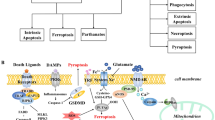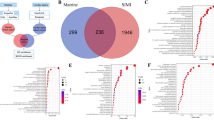Abstract
This study aimed to identify the effect of β-caryophyllene (BCP) pretreatment and elucidate the Nrf2/HO-1 signaling mechanism after focal cerebral ischemia-reperfusion (I-R) injury in rats. Adult male Sprague–Dawley rats were randomly assigned to the sham-operated group, I-R group and BCP pretreated I-R group. At 24 h after reperfusion, neurological deficits and infarct volume were evaluated. Pathological changes of neuron in hippocampuses were observed by Nissil staining and transmission electron microscopy (TEM). Oxidative stress was assessed by malondialdehyde (MDA) level, lipid peroxidation (LPO), nitric oxide (NO), superoxide dismutase (SOD) and Catalase (CAT) activity. The expression levels of nuclear factor erythroid 2-related factor 2 (Nrf2) and heme oxygenase-1 (HO-1) were analysed by Western blotting and real-time quantitative polymerase chain reaction (Q-PCR). The protein expression of Bcl-2 and Bax was determined by immunohistochemistry. Apoptotic cells were detected using TUNEL staining. In I-R group, neurological deficit scores, cerebral infarct volume, MDA levels, LPO content, NO level, expression of Bax and TUNEL-positive cells were found to be increased at 24 h after I-R injury, while SOD activity, CAT activity and expression of Bcl-2 were decreased. However, results in the BCP pretreatment groups were reversed. And the protein and mRNA expressions of Nrf2 and HO-1 were significantly up-regulated in the BCP pretreated I-R group. Results of Nissil staining and TEM scan manifested that BCP remarkablely improved neuronal injury after I-R in rats. All the above suggested that BCP pretreatment played a neuroprotective role in cerebral I-R injury, which might be exerted by upregulating the expression of Nrf2 and HO-1 to ameliorate oxidative damage and neuronal apoptosis.














Similar content being viewed by others
References
Feigin VL, Lawes CMM, Bennett DA, Anderson CS (2003) Stroke epidemiology: a review of population-based studies of incidence, prevalence, and case-fatality in the late 20th century. Lancet Neurol 2:43–53
Hicks KA, Tcheng JE, Bozkurt B, Chaitman BR, Cutlip DE, Farb A, Fonarow GC, Jacobs JP, Jaff MR, Lichtman JH, Limacher MC, Mahaffey KW, Mehran R, Nissen SE, Smith EE, Targum SL (2015) 2014 ACC/AHA key data elements and definitions for cardiovascular endpoint events in clinical trials: a report of the American College of Cardiology/American Heart Association Task Force on Clinical Data Standards (Writing Committee to Develop Cardiovascular Endpoints Data Standards). J Am Coll Cardiol 66:403–469
Yang Long Xiu, Wang Wei, Zhang Xiao, Zhu Qi, Zhao Qing, Zhao Gang (2015) The endonuclease VIII-like proteins: new targets in the treatment of ischemic stroke? Neuroimmunol Neuroinflamm 1:13–14
Venna VR, McCullough LD (2015) Differences in stroke damage in aged mice may not be due to differential cerebral blood flow dynamics. Neuroimmunol Neuroinflamm 4:281–286
Xu Z, Xu RX, Liu BS, Jiang XD, Huang T, Ding LS, Yuan J (2005) Time window characteristics of cultured rat hippocampal neurons subjected to ischemia and reperfusion. Chin J Traumatol 8:179–182
Chan PH (1996) Role of oxidants in ischemic brain damage. Stroke 27:1124–1129
Sharipov RR, Kotsiuruba AV, Kopiak BS, Sahach VF (2014) Induction of oxidative stress in heart mitochondria in brain focal ischemia-reperfusion and protective effect of ecdysterone. Fiziolohichnyi zhurnal 60:11–17
Li Volti G, Sorrenti V, Murabito P, Galvano F, Veroux M, Gullo A, Acquaviva R, Stacchiotti A, Bonomini F, Vanella L, Di Giacomo C (2007) Pharmacological induction of heme oxygenase-1 inhibits iNOS and oxidative stress in renal ischemia-reperfusion injury. Transpl Proc 39:2986–2991
Alfieri A, Srivastava S, Siow RC, Cash D, Modo M, Duchen MR, Fraser PA, Williams SC, Mann GE (2013) Sulforaphane preconditioning of the Nrf2/HO-1 defense pathway protects the cerebral vasculature against blood-brain barrier disruption and neurological deficits in stroke. Free Radic Biol Med 65:1012–1022
Peng B, Zhao P, Lu YP, Chen MM, Sun H, Wu XM, Zhu L (2013) Z-ligustilide activates the Nrf2/HO-1 pathway and protects against cerebral ischemia-reperfusion injury in vivo and in vitro. Brain Res 1520:168–177
Paula-Freire LI, Andersen ML, Gama VS, Molska GR, Carlini EL (2014) The oral administration of trans-caryophyllene attenuates acute and chronic pain in mice. Phytomedicine 21:356–362
Bento AF, Marcon R, Dutra RC, Claudino RF, Cola M, Leite DF, Calixto JB (2011) Beta-caryophyllene inhibits dextran sulfate sodium-induced colitis in mice through CB2 receptor activation and PPARgamma pathway. Am J Pathol 178:1153–1166
Galdino PM, Nascimento MV, Florentino IF, Lino RC, Fajemiroye JO, Chaibub BA, de Paula JR, de Lima TC, Costa EA (2012) The anxiolytic-like effect of an essential oil derived from Spiranthera odoratissima A. St. Hil. leaves and its major component, beta-caryophyllene, in male mice. Prog Neuropsychopharmacol Biol Psychiatry 38:276–284
Kim C, Cho SK, Kim KD, Nam D, Chung WS, Jang HJ, Lee SG, Shim BS, Sethi G, Ahn KS (2014) Beta-caryophyllene oxide potentiates TNFalpha-induced apoptosis and inhibits invasion through down-modulation of NF-kappaB-regulated gene products. Apoptosis 19:708–718
Calleja MA, Vieites JM, Montero-Melendez T, Torres MI, Faus MJ, Gil A, Suarez A (2013) The antioxidant effect of beta-caryophyllene protects rat liver from carbon tetrachloride-induced fibrosis by inhibiting hepatic stellate cell activation. Br J Nutr 109:394–401
Liu H, Song Z, Liao D, Zhang T, Liu F, Zhuang K, Luo K, Yang L (2015) Neuroprotective effects of trans-caryophyllene against kainic acid induced seizure activity and oxidative stress in mice. Neurochem Res 40:118–123
Guo K, Mou X, Huang J, Xiong N, Li H (2014) Trans-caryophyllene suppresses hypoxia-induced neuroinflammatory responses by inhibiting NF-kappaB activation in microglia. J Mol Neurosci 54:41–48
Opdyke DL (1973) Monographs on fragrance raw materials. Food Cosmet Toxicol 11:1011–1081
Assis LC, Straliotto MR, Engel D, Hort MA, Dutra RC, de Bem AF (2014) Beta-caryophyllene protects the C6 glioma cells against glutamate-induced excitotoxicity through the Nrf2 pathway. Neuroscience 279:220–231
Legault J, Pichette A (2007) Potentiating effect of beta-caryophyllene on anticancer activity of alpha-humulene, isocaryophyllene and paclitaxel. J Pharm Pharmacol 59:1643–1647
Ren J, Fan C, Chen N, Huang J, Yang Q (2011) Resveratrol pretreatment attenuates cerebral ischemic injury by upregulating expression of transcription factor Nrf2 and HO-1 in rats. Neurochem Res 36:2352–2362
Cheng Y, Dong Z, Liu S (2014) beta-Caryophyllene ameliorates the Alzheimer-like phenotype in APP/PS1 Mice through CB2 receptor activation and the PPARgamma pathway. Pharmacology 94:1–12
Al Mansouri S, Ojha S, Al Maamari E, Al Ameri M, Nurulain SM, Bahi A (2014) The cannabinoid receptor 2 agonist, beta-caryophyllene, reduced voluntary alcohol intake and attenuated ethanol-induced place preference and sensitivity in mice. Pharmacol Biochem Behav 124:260–268
Longa EZ, Weinstein PR, Carlson S et al (1989) Reversible middle cerebral artery occlusion without craniectomy in rats. Stroke 20:84–91
Fridovich I (1983) Superoxide radical: an endogenous toxicant. Annu Rev Pharmacol Toxicol 23:239–257
He M, Xing S, Yang B, Zhao L, Hua H, Liang Z, Zhou W, Zeng J, Pei Z (2007) Ebselen attenuates oxidative DNA damage and enhances its repair activity in the thalamus after focal cortical infarction in hypertensive rats. Brain Res 1181:83–92
Roger VL, Go AS, Lloyd-Jones DM, Adams RJ, Berry JD, Brown TM, Carnethon MR, Dai S, de Simone G, Ford ES, Fox CS, Fullerton HJ, Gillespie C, Greenlund KJ, Hailpern SM, Heit JA, Ho PM, Howard VJ, Kissela BM, Kittner SJ, Lackland DT, Lichtman JH, Lisabeth LD, Makuc DM, Marcus GM, Marelli A, Matchar DB, McDermott MM, Meigs JB, Moy CS, Mozaffarian D, Mussolino ME, Nichol G, Paynter NP, Rosamond WD, Sorlie PD, Stafford RS, Turan TN, Turner MB, Wong ND, Wylie-Rosett J, American Heart Association Statistics C, Stroke Statistics S (2011) Heart disease and stroke statistics–2011 update: a report from the American Heart Association. Circulation 123:e18–e209
Donnan GA, Fisher M, Macleod M, Davis SM (2008) Stroke. Lancet 371:1612–1623
Candelario-Jalil E (2009) Injury and repair mechanisms in ischemic stroke: considerations for the development of novel neurotherapeutics. Curr Opin Investig Drugs 10:644–654
Jia D, Han B, Yang S, Zhao J (2014) Anemonin alleviates nerve injury after cerebral ischemia and reperfusion (I/R) in rats by improving antioxidant activities and inhibiting apoptosis pathway. J Mol Neurosci 53:271–279
Alderazi YJ, Grotta JC (2014) Acute antithrombotic treatment of ischemic stroke. Curr Vasc Pharmacol 12:353–364
Aras M, Altas M, Meydan S, Nacar E, Karcioglu M, Ulutas KT, Serarslan Y (2014) Effects of ebselen on ischemia/reperfusion injury in rat brain. Int J Neurosci 124:771–776
Shah ZA, Li RC, Thimmulappa RK, Kensler TW, Yamamoto M, Biswal S, Dore S (2007) Role of reactive oxygen species in modulation of Nrf2 following ischemic reperfusion injury. Neuroscience 147:53–59
Takeda A, Onodera H, Sugimoto A, Itoyama Y, Kogure K, Shibahara S (1994) Increased expression of heme oxygenase mRNA in rat brain following transient forebrain ischemia. Brain Res 666:120–124
Chen-Roetling J, Regan RF (2006) Effect of heme oxygenase-1 on the vulnerability of astrocytes and neurons to hemoglobin. Biochem Biophys Res Commun 350:233–237
Soane L, Li Dai W, Fiskum G, Bambrick LL (2010) Sulforaphane protects immature hippocampal neurons against death caused by exposure to hemin or to oxygen and glucose deprivation. J Neurosci Res 88:1355–1363
Son TG, Camandola S, Arumugam TV, Cutler RG, Telljohann RS, Mughal MR, Moore TA, Luo W, Yu QS, Johnson DA, Johnson JA, Greig NH, Mattson MP (2010) Plumbagin, a novel Nrf2/ARE activator, protects against cerebral ischemia. J Neurochem 112:1316–1326
Shah ZA, Li RC, Ahmad AS, Kensler TW, Yamamoto M, Biswal S, Dore S (2010) The flavanol (−)-epicatechin prevents stroke damage through the Nrf2/HO1 pathway. J Cereb Blood Flow Metab 30:1951–1961
Niture SK, Jaiswal AK (2012) Nrf2 protein up-regulates antiapoptotic protein Bcl-2 and prevents cellular apoptosis. J Biol Chem 287:9873–9886
Milanlioglu A, Aslan M, Ozkol H, Cilingir V, Nuri Aydin M, Karadas S (2015) Serum antioxidant enzymes activities and oxidative stress levels in patients with acute ischemic stroke: influence on neurological status and outcome. Wiener klinische Wochenschrift
Sun J, Wang F, Li H, Zhang H, Jin J, Chen W, Pang M, Yu J, He Y, Liu J, Liu C (2015) Neuroprotective effect of sodium butyrate against cerebral ischemia/reperfusion injury in mice. BioMed Res Int 2015:395895
Zhang Y, Milatovic D, Aschner M, Feustel PJ, Kimelberg HK (2007) Neuroprotection by tamoxifen in focal cerebral ischemia is not mediated by an agonist action at estrogen receptors but is associated with antioxidant activity. Exp Neurol 204:819–827
Sharpe PC, Mulholland C, Trinick T (1994) Ascorbate and malondialdehyde in stroke patients. Ir J Med Sci 163:488–491
Kotur-Stevuljevic J, Bogavac-Stanojevic N, Jelic-Ivanovic Z, Stefanovic A, Gojkovic T, Joksic J, Sopic M, Gulan B, Janac J, Milosevic S (2015) Oxidative stress and paraoxonase 1 status in acute ischemic stroke patients. Atherosclerosis 241:192–198
Abd-Elsameea AA, Moustaf AA, Mohamed AM (2014) Modulation of the oxidative stress by metformin in the cerebrum of rats exposed to global cerebral ischemia and ischemia/reperfusion. Eur Rev Med Pharmacol Sci 18:2387–2392
Sekhon B, Sekhon C, Khan M, Patel SJ, Singh I, Singh AK (2003) N-Acetyl cysteine protects against injury in a rat model of focal cerebral ischemia. Brain Res 971:1–8
Buch P, Patel V, Ranpariya V, Sheth N, Parmar S (2012) Neuroprotective activity of Cymbopogon martinii against cerebral ischemia/reperfusion-induced oxidative stress in rats. J Ethnopharmacol 142:35–40
Bedirli N, Bagriacik EU, Emmez H, Yilmaz G, Unal Y, Ozkose Z (2012) Sevoflurane and isoflurane preconditioning provides neuroprotection by inhibition of apoptosis-related mRNA expression in a rat model of focal cerebral ischemia. J Neurosurg Anesthesiol 24:336–344
Verma S, Singh A, Mishra A (2015) Complex disruption effect of natural polyphenols on Bcl-2-Bax: molecular dynamics simulation and essential dynamics study. J Biomol Struct Dyn 33:1094–1106
Aboutaleb N, Shamsaei N, Khaksari M, Erfani S, Rajabi H, Nikbakht F (2015) Pre-ischemic exercise reduces apoptosis in hippocampal CA3 cells after cerebral ischemia by modulation of the Bax/Bcl-2 proteins ratio and prevention of caspase-3 activation. J Physiol Sci 65:435–443
Zhu L, Han MB, Gao Y, Wang H, Dai L, Wen Y, Na LX (2015) Curcumin triggers apoptosis via upregulation of Bax/Bcl-2 ratio and caspase activation in SW872 human adipocytes. Mol Med Rep 12:1151–1156
Author information
Authors and Affiliations
Corresponding authors
Additional information
Jie Lou and Guangxiu Cao have contributed equally to this work.
Rights and permissions
About this article
Cite this article
Lou, J., Cao, G., Li, R. et al. β-Caryophyllene Attenuates Focal Cerebral Ischemia-Reperfusion Injury by Nrf2/HO-1 Pathway in Rats. Neurochem Res 41, 1291–1304 (2016). https://doi.org/10.1007/s11064-016-1826-z
Received:
Revised:
Accepted:
Published:
Issue Date:
DOI: https://doi.org/10.1007/s11064-016-1826-z




